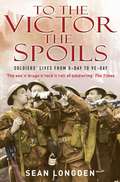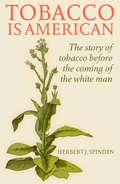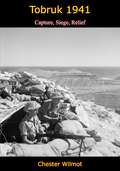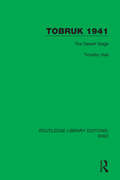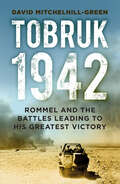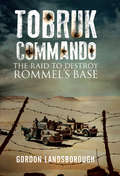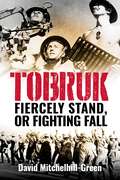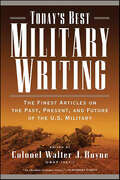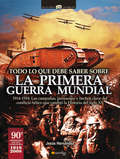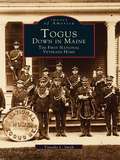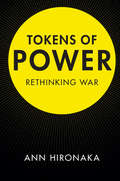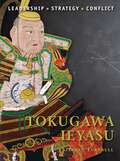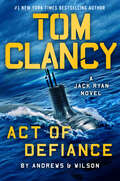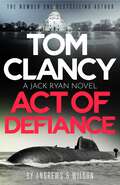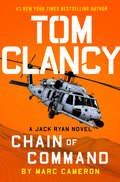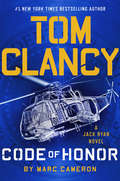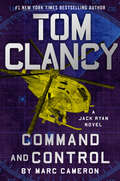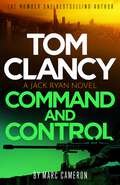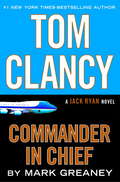- Table View
- List View
To the Victor the Spoils
by Sean LongdenFrom the D-Day landings in June 1944 to the final declaration of peace the following year the Allied forces fought a bitter battle to the end against Hitler's Nazi Germany. Sean Longden re-tells the unexpected true story of life among the ranks of Field Marshall Montgomery's 21st Army group and reveals a tale of sex, burglary, rape, pillage and alcohol. Uncovering new material from interviews, documents and personal accounts, Sean Longden recounts what really happened on the road to Berlin. 'A meticulously-researched, utterly absorbing account of the human story behind the battle to crush Hitler's forces.' Yorkshire Post'From D-Day to VE Day, historian Sean Longden reveals the sex 'n' rock 'n' drugs 'n' rock 'n' roll of soldiering' The Times
Tobacco: The Story of Tobacco Before the Coming of the White Man
by Joseph C. RobertTobacco is American, first published in 1950, is a well-researched, fascinating look at the history of Native American use of tobacco and its introduction into European cultures. As one reviewer stated, “nothing is so American as tobacco,” and the Mayans and North and South American tribes used the plant in rituals and healing ceremonies for centuries. Included are chapters on the origins of smoking, pipes, the word 'tobacco,' botanical considerations of the several Nicotiana species, and medicinal and ritualistic uses. Included are 21 pages of maps and illustrations. Author Herbert Spinden was curator of American Indian art and primitive culture at the Brooklyn Museum.
Tobruk 1941: Capture, Siege, Relief (Text Classics Ser.)
by Chester WilmotLike Gallipoli, the coastal fortress of Tobruk in northern Africa has a special place in Australian’s war annals. For eight month in 1941 the Australian Imperial Force helped hold the besieged town against German forces that had hitherto suffered no check.With the distinctive mix of vigour and intelligence that made him a celebrated correspondent during and after the Second World War, Chester Wilmot here tells the story of the fighting in and around Tobruk from January to December 1941. His compelling book, based on personal observation, official documents and eyewitness accounts, is given even greater impact by the use of enemy sources including extracts from the diaries of German officers.As well as commemorating the achievement of the besieged Allied troops against the superior strength of the Germans, Tobruk gives an exceptionally readable insight into the critical North African campaign.“Tobruk set an example of courage in the face of superior strength, of firm spirit in spite of hardship, of cheerful defiance and offensive defence.”—CHESTER WILMOT
Tobruk 1941: The Desert Siege (Routledge Library Editions: WW2 #34)
by Timothy HallThis book, first published in 1984, examines the 1941 siege of Tobruk and the experiences of the inexperienced Australian troops facing Rommel’s successful armies. It looks at the follies as well as the bravery; humane acts from both sides, locked as they were in a brutal battle; the tactics of desert warfare and siege warfare; and the challenges both sides faced from fighting in desert conditions.
Tobruk 1942: Rommel and the Battles Leading to His Greatest Victory
by David Mitchelhill-GreenTobruk was one of the greatest Allied victories – and one of the worst Allied defeats – of the Second World War. The 1942 fiasco rocked the very foundation of Winston Churchill’s premiership. It revived the flagging hopes of the German people and fanned the flames of Arab unrest. Furthering Rommel’s ascendency and souring relations within the British Commonwealth, it marked a turning point in Anglo-American relations in the fight against Adolf Hitler’s Third Reich.Utilising a wealth of primary and secondary sources, Tobruk 1942 examines why the fortress fell to Rommel’s Axis forces in just 24 hours when it held out against repeated attacks the previous year. Comparing the 1941 and 1942 battles, this book presents a new perspective on Tobruk – the isolated Libyan fortress, and symbol of Allied freedom, which for a period in the war captured the world’s attention.
Tobruk Commando: The Raid to Destroy Rommel's Base
by Gordon Landsborough"Gentlemen, we are going to capture Tobruk and destroy it."'Operation Agreement' started as a fairly simple plan to destroy Rommel's bomb-proof oil-storage tanks at Tobruk on the eve of Alamein. But, catching the imagination of GHQ, the plan snowballed alarmingly. As well as a commando unit led by the plan's originator, Colonel Haselden, it came to include the RAF, the Royal Navy, the Marines and two of the largest destroyers in the Mediterranean.It was a daring attempt to rob Rommel at one stroke of the three essentials to success in North Africa - oil, a supply port and shipping. But the calculated risks began to out balance the chances of success when it seemed that every dockyard worker in Alexandria and every cocktail-party-goer in Cairo knew about the raid before the officers and men set out. The operation went on, and became a tragedy of slaughtered men and sunken ships.Tobruk Commando is a classic adventure story of the Second World War. The fast-moving action centres on the small commando of men which set out secretly through the deserts towards Tobruk. After a long journey across the desert sand, they arrived disguised as a group of POWs and their German captors. Expertly written, this is a wonderful tale of heroic bluff and a venture to test the courage and nerves of the toughest men.
Tobruk: Firecely Stand or Fighting Fall
by David Mitchelhill-GreenTobruk was one of the greatest Allied victories – and one of the worst Allied defeats – of the Second World War. The eight-month long 1941 siege – a defiant stand by the so-called &‘Rats of Tobruk&’ – captured the world&’s attention. Conversely, the fall of Tobruk in June 1942 came a shock to the Allies in the wake of Japan&’s entry into the war and a string of defeats in the Far East. It rocked the foundation of Winston Churchill&’s premiership, revived the flagging hopes of the German people and fanned the flames of Arab unrest. It furthered Rommel&’s ascendency and marked a turning point in Anglo-American relations and the fight against Nazi Germany.Tobruk: Fiercely Stand, or Fighting Fall presents a new perspective – asking why the remote fortress successfully fought off repeated attacks in 1941, before tragically falling to Rommel&’s Axis forces in just 24 hours in mid-1942. It begins with Italy&’s invasion of Ottoman-held North Africa in 1911, before introducing key individuals - Rommel, Mussolini and Morshead – to examine how their WWI service shaped later events. From Mussolini&’s ill-fated invasion of Egypt in September 1940, the book explores the capture of Tobruk in January 1941 by the Australian 6th Division, the ensuing siege of its sister 9th Division, and the fortress&’ disastrous capitulation.
Toby's Room (Life Class Trilogy #2)
by Pat BarkerPat Barker confirms her place in the pantheon of Britain's finest novelists with a masterful novel that portrays the staggering human cost of the Great War. Admirers of the Regeneration trilogy and fans of Downton Abbey alike will be enthralled.The incomparable Booker Prize winner once again demonstrates her ability to eloquently convey simple, moving truths. The enormity of the war's impact--not only on soldiers at the front but on the loved ones they leave behind--is poignantly expressed in her unflinching and elegant prose.
Toda nuestra juventud
by Mathieu LegendreLa odisea del camillero Tabouret. De1914 a 1919 siga a Camille Tabouret en los principales escenarios de operación en el frente de batalla francés. Adaptando el diario de guerra original de Camille Tabouret, Mathieu Legendre hizo un relato dinámico y moderno, y nos permite descubrir el fin de todas las guerras de forma original. Acompañamos a Camille en la misión de rescatar a los heridos y muertos lo más cerca de las líneas enemigas, en el infierno de las trincheras y los desplazamientos de su regimiento. Superviviente de ese conflicto, Camille nos dejó un testimonio extraordinario, ahora accesible para todos.
Todas las piezas rotas
by John BoyneUna historia conmovedora sobre una anciana que debe enfrentarse a su terrible pasado. Una secuela magistral de El niño con el pijama de rayas. Cuando Bruno decidió acompañar a su amigo Shmuel a la cámara de gas, ¿qué ocurrió con su hermana, Gretel, y sus padres? ¿Sobrevivió su familia a la guerra y los estragos del nazismo? Gretel Fernsby es ahora una anciana de 91 años que vive cómodamente en un apartamento en una de las zonas más acomodadas de Londres. Cuando una joven familia se muda al piso de abajo, Gretel no puede evitar entablar amistad con Henry, el hijo pequeño de la pareja. Una noche, tras ser testigo de una violenta discusión entre la madre de Henry y su dominante padre, Gretel se enfrenta a la oportunidad de expiar la culpa, el dolor y el remordimiento y hacer algo por salvar a un niño, por segunda vez en su vida. Pero para ello se verá obligada a revelar su verdadera identidad... Elogios sobre el autor:«John Boyne posee una enfermiza obsesión por colarse en la historia con mayúsculas. [...] También se empeña en jugar con temas eternos, como la lucha del bien contra el mal y en otros asuntos polémicos como la redención literaria.»Jesús Ruiz Mantilla, El País «Un escritor que no para de crecer.»Xavi Ayén, La Vanguardia «Es lo bueno que tiene Boyne y su manera de contar los hechos, sean estos cuales sean: la sencillez al servicio de unas historias muy bien hiladas desde el arranque mismo de la trama. Vamos, que empiezas y no la sueltas.»Laura Revuelta, ABC
Today's Best Military Writing: The Finest Articles on the Past, Present, and Future of the U.S. Military
by Walter J. BoyneToday's Best Military Writing is the first-ever collection of the finest articles on the military published in recent years. Esteemed military historian and bestselling author Walter J. Boyne has gathered twenty-one writers, both military and civilian, and their published articles and essays on all aspects of the various branches of the armed forces and on the military history of the United States.From searching analyses of wars spanning two centuries to examinations of how our country's modern armed forces are coping with new threats that are more dangerous than any they've faced before, these articles represent the best of the best---incisive, thoughtful, and probing opinions and information, often written by the people who have lived and breathed their topics.Article subjects in this volume include:*A chillingly logical hypothesis that could be the next step in terrorism--mating cruise missiles with biological warfare*A call to assign coastal U.S. defense to the branch of the armed forces that is most equipped to deal with it--the Coast Guard*The history and development of the F-15 Eagle, one of the most famous jet fighters in the world*Little known facts about the use and deployment of artillery pieces during the Indian Wars of 1860-1890*The role of U.S. Army chaplains tending to German war criminals during the Nuremberg Trials.At the Publisher's request, this title is being sold without Digital Rights Management Software (DRM) applied.
Today's Military Wife
by Lydia Sloan ClineEssential information for servicemembers' wives and families. Benefits, resources, and sound advice for a quality life in the service.
Todo lo que debe saber sobre la 1ª Guerra Mundial (Historia Incógnita)
by Jesús Hernández MartínezImprescindible relato sobre la Gran Guerra, ágil, ameno y a la vez estricto y riguroso en sus acotaciones históricas y bélicas, características que definen a Jesús Hernández, uno e los autores que más vende sobre temática bélica en España.
Togus, Down in Maine: The First National Veterans Home
by Timothy L. SmithTogus, located 4.5 miles east of Augusta, Maine, was formerly part of the town of Chelsea. After the Civil War, Congress enacted laws and established a system of facilities that collectively became known as "National Homes for Disabled Volunteer Soldiers." The critical need to establish an eastern branch of the National Home led to the selection of the former Togus Spring Hotel, which after some remodeling, opened for Union Civil War veterans inNovember 1866. Gathered from cherished family albums, collectors of Togus artifacts, libraries, and archives, Togus, Down in Maine: The First National Veterans Home represents the first published history of the area, and most of the photographs have not been viewed by the public. The images of Civil War veterans are of particular interest, along with views of buildings, barracks, and hospitals from 1866 to the 1930s. From 1932 to 1960, over 60 buildings were demolished, and new buildings with reinforced concrete and brick facings were built.
Tokens of Power
by Ann HironakaWar presents a curious paradox. Interstate war is arguably the most carefully planned endeavor by states, yet military history is filled with disasters and blunders of monumental proportions. These anomalies happen because most military history presumes that states are pursuing optimal strategies in a competitive environment. This book offers an alternative narrative in which the pillars of military planning - evaluations of power, strategy, and interests - are theorized as social constructions rather than simple material realities. States may be fighting wars primarily to gain or maintain power, yet in any given historical era such pursuits serve only to propel competition; they do not ensure military success in subsequent generations. Allowing states to embark on hapless military ventures is fraught with risks, while the rewards are few.
Tokugawa Ieyasu
by Stephen Turnbull Giuseppe RavaTowards the end of the 16th century three outstanding commanders brought Japan's century of civil wars to an end, and even though reunification was first achieved under Toyotomi Hideyoshi, it was his successor Tokugawa Ieyasu who was to ensure a lasting peace. In terms of his strategic and political achievements Ieyasu ranks as Japan's greatest samurai commander. His battlefield prowess, however, needs careful consideration before accolades are offered, because Ieyasu was undoubtedly a lucky general. Mikata ga Hara, for example, was a defeat that the onset of winter saved from being a rout. Ieyasu's crowning victory at Sekigahara depended very much on the defection to his side of Kobayakawa Hideaki, and the absence from the scene of Ieyasu's son Hidetada serves to illustrate how just once there was a failure in Ieyasu's otherwise classic strategic vision. Yet Ieyasu possessed the particular wisdom of knowing who should be an ally and who was an enemy, and he was gifted in the broad brush strokes of a campaign. He also knew how to learn from his mistakes.Ieyasu was also patient, a virtue sadly lacking in many of his contemporaries, and unlike Hideyoshi never outreached himself. To establish his family as the ruling clan in Japan for the next two and a half centuries was abundant proof of his true greatness.
Tolerance Discourse and Young Adult Holocaust Literature: Engaging Difference and Identity (Children's Literature and Culture)
by Rachel Dean-RuzickaWhat, exactly, does one mean when idealizing tolerance as a solution to cultural conflict? This book examines a wide range of young adult texts, both fiction and memoir, representing the experiences of young adults during WWII and the Holocaust. Author Rachel Dean-Ruzicka argues for a progressive reading of this literature. Tolerance Discourse and Young Adult Holocaust Literature contests the modern discourse of tolerance, encouraging educators and readers to more deeply engage with difference and identity when studying Holocaust texts. Young adult Holocaust literature is an important nexus for examining issues of identity and difference because it directly confronts systems of power, privilege, and personhood. The text delves into the wealth of material available and examines over forty books written for young readers on the Holocaust and, in the last chapter, neo-Nazism. The book also looks at representations of non-Jewish victims, such as the Romani, the disabled, and homosexuals. In addition to critical analysis of the texts, each chapter reads the discourses of tolerance and cosmopolitanism against present-day cultural contexts: ongoing debates regarding multicultural education, gay and lesbian rights, and neo-Nazi activities. The book addresses essential questions of tolerance and toleration that have not been otherwise considered in Holocaust studies or cultural studies of children’s literature.
Tom Clancy - Three Complete Novels: Patriot Games; Clear And Present Danger; The Sum Of All Fears
by Tom ClancyOver the course of his novels, Tom Clancy's "genius for big, compelling plots" and his "natural narrative gift" (The New York Times Magazine) have mesmerized tens of millions of readers—more than 42 million of his books are in print in the United States alone—and established him as one of the preeminent storytellers of our time. Here, complete and unabridged, are three of his best: heart-stopping classics of action, suspense, and the exceptional realism that is his hallmark. PATRIOT GAMES: When Jack Ryan breaks up a terrorist attack in London, he has no idea that he has just saved the lives of the Prince and Princess of Wales. However, he has also gained the enmity of the Ulster Liberation Army, an ultra-left-wing splinter group of the IRA—and soon it is Ryan himself who is their target. CLEAR AND PRESENT DANGER: Colombian drug lords assassinate three high American officials, and the United States decides to take the fight to the enemy. But does anyone know who the real enemy is, and which lines cannot be crossed? Jack Ryan and his field operative, Mr. Clark, must find out, little realizing that though there will be danger from without, the danger from within will be the greatest of all. THE SUM OF ALL FEARS: With one terrible act, the world is plunged into an instant nuclear crisis, and a floundering president into the ultimate nightmare. As nations stand on the brink of war, Ryan and his FBI counterpart frantically seek a solution before the chiefs of state lose control of themselves—and the world.
Tom Clancy Act of Defiance (A Jack Ryan Novel #24)
by Brian Andrews Jeffrey WilsonA rogue nuclear Russian submarine is steaming toward the East Coast of the United States. For President Jack Ryan, memories of past events may seem stunningly vivid, but the dangers are terrifyingly real in the latest entry in this #1 New York Times bestselling series.US intelligence is reporting turmoil in the Russian navy. Their deadliest submarine, the Belgorod, has unexpectedly launched, and taken along with it a long list of questions. Who authorized the departure? What mission is it on? And, most disturbing of all, what weapons do the giant doors on the sub&’s bow hide? It's been four decades since a similar incident with the Soviet sub, Red October, ended happily, thanks to a young CIA analyst named Jack Ryan. Now, President Jack Ryan finds himself with fleets of ships, squadrons of jets, and teams of SEALs at his command, but what he doesn&’t have is insight into the plans of the Belgorod&’s commander. It falls to a younger generation of Ryans to do the dangerous work that will reveal that information. But there&’s always a price to be paid. When the final moments tick away, will Jack Ryan have to choose between the safety of his country and the safety of his child?
Tom Clancy Act of Defiance: The unmissable gasp-a-page Jack Ryan thriller (Jack Ryan #24)
by Brian Andrews Jeffrey WilsonFOR JACK RYAN, THE GREATEST THREAT LURKS BENEATH THE WAVES . . . AGAIN When a Russian superweapon is let loose under the waves, it's up to President Jack Ryan to find a countermove in the latest entry in this #1 New York Times bestselling series.US intelligence is reporting turmoil in the Russian navy. Their deadliest submarine, the Belgorod, has unexpectedly launched. Who authorised the departure? What mission is it on? And, most disturbing of all, what weapons do the giant doors on the sub's bow hide?It's been four decades since a similar incident with the Soviet sub, Red October, ended happily, thanks to a young CIA analyst named Jack Ryan.Now, President Jack Ryan finds himself with fleets of ships, squadrons of jets, and teams of SEALs at his command, but what he doesn't have is insight into the plans of the Belgorod's commander. It falls to a younger generation of Ryans to do the dangerous work that will reveal that information.But there's always a price to be paid. When the final moments tick away, will Jack Ryan have to choose between the safety of his country and the safety of his child?___________PRAISE FOR TOM CLANCY'Constantly taps the current world situation for its imminent dangers and spins them into an engrossing tale'NEW YORK TIMES'Exhilarating. No other novelist is giving so full a picture of modern conflict'SUNDAY TIMES'A brilliantly constructed thriller that packs a punch'DAILY MAIL'Heart-stopping action . . . entertaining and eminently topical'WASHINGTON POST
Tom Clancy Chain of Command (A Jack Ryan Novel #21)
by Marc CameronThe United States has stared down many threats with President Jack Ryan at the helm, but what if he&’s not there when we need him? That&’s the question facing a nation in the most shocking entry in Tom Clancy's #1 New York Times bestselling series.A shadowy billionaire uses his fortune to further his corrupt ambitions. Along the way, he&’s toppled democratically elected governments and exacerbated divisions within stable nations. The competitors he&’s destroyed, the people he&’s hurt, they&’re all just marks on a ledger. Now, he&’s ready to implement his most ambitious plan of all. There&’s only one force standing in his way—President Jack Ryan.How do you compel a man like Jack Ryan to bend? He&’s personally faced down everything from the Russian navy to cartel killers. It will take more than political headwinds or media disfavor to cause him to turn from his duty to the American people, but every man has an Achilles heel. Jack Ryan&’s is his family.The answer is as simple as it is shocking. The billionaire has assembled an international team of the most ruthless mercenaries alive. Their mission—kidnap the First Lady.
Tom Clancy Code of Honor (A Jack Ryan Novel #19)
by Marc CameronAs President of the United States, Jack Ryan has faced many challenges, but none have been as personal as this and never has he been this helpless in the face of evil in the latest entry in Tom Clancy's #1 New York Times bestselling series.Father Pat West, S.J. was a buddy of the young Jack Ryan when they were both undergraduates at Boston College. Father West left a comfortable job in the philosophy department at Georgetown to work with the poor in Indonesia. Now he's been arrested and accused of blasphemy against Islam. President Ryan is desperate to rescue his old friend, but he can't move officially against the Indonesians. Instead he relies on the Campus team to find out who is framing the priest. There's one other twist to the story. President Ryan discovers a text on his private cell phone from the priest warning about a coming attack against America...
Tom Clancy Command and Control (A Jack Ryan Novel #23)
by Marc CameronA Russian plot to seize the Panama Canal plunges President Jack Ryan into a desperate fight for his life in the latest entry in the #1 New York Times bestselling series.For a century, the Panama Canal has served as the path between the seas. Control of this vital waterway is the difference between free trade and chaos in world markets.So when Panamanian President Rafael Botero asks for a show of support against the socialist opposition, his old friend President Jack Ryan can&’t turn down an invitation to visit the country, but what seems like an ordinary opportunity to preach the values of democracy quickly turns into a nightmare when a full-blown coup d&’état erupts.President Ryan and his Secret Service team are cut off and out of communication. In Washington, the Vice President is coordinating a military response, but there's still one more obstacle.One of the main forces behind the coup is the ruthless criminal organization known as the Camarilla. They&’ve had their tentacles deep inside the plot to overthrow the government. All of their hard work has just presented them with an unexpected opportunity they can&’t resist—the chance to kill President Jack Ryan.
Tom Clancy Command and Control: The tense, superb new Jack Ryan thriller (Jack Ryan #23)
by Marc CameronJACK RYAN IS TRAPPED. AN ASSASSIN INCOMING. TIME TO TAKE CONTROL.A Russian plot to seize the Panama Canal plunges President Jack Ryan into a desperate fight for his life in the latest entry in the #1 New York Times bestselling series.President Jack Ryan travels to Colombia to support the president who is facing a challenge from autocratic forces. What seems like an ordinary opportunity to preach the values of democracy quickly turns into a nightmare when a full-blown military coup erupts. President Ryan and his Secret Service team are cut off and out of communication. In Washington, the Vice President is coordinating a military response, but there's still one more obstacle. One of the main forces behind the coup is the ruthless criminal organization known as the Camarilla. They've had their tentacles deep inside the plot to overthrow the government. And now they have an unexpected opportunity they can't resist - the chance to kill President Jack Ryan.
Tom Clancy Commander in Chief
by Mark GreaneyThis electrifying thriller in the #1 New York Times bestselling series has President Jack Ryan and his allies facing a treacherous foe threatening to unleash chaos around the globe...When Russian President Valeri Volodin’s ambitions are foiled in Dagestan, he faces a difficult choice. The oligarchs who support him expect a constant flow of graft, but with energy prices cratering, the Russian economy sputters to a virtual halt. Unable to grow the Russian market at home, his hold on power relies on expansion abroad—a plan that has been thwarted by the United States in the past. But this time Volodin has determined that an indirect approach is the best. A floating natural gas facility in Lithuania is blown up. A Venezuelan prosecutor is assassinated. A devastating attack on a Russian troop train kills dozens. A chaotic world is the best camouflage for a series of seemingly unrelated attacks. Only one man recognizes an ominous pattern in the reports of terror from around the globe. U.S. President Jack Ryan sees a guiding hand in the worldwide chaos, but before he can act he needs proof. While his intelligence agencies race to uncover the truth behind the attacks, the President struggles to unite a fractious and distrustful coalition of Western nations against the schemes of the Russian dictator. With five thousand Russian troops poised to invade a NATO nation, can Jack Ryan move swiftly enough to stop Volodin’s grand plan of global conflict and conquest? Or will he succeed in changing the balance of world power forever?
